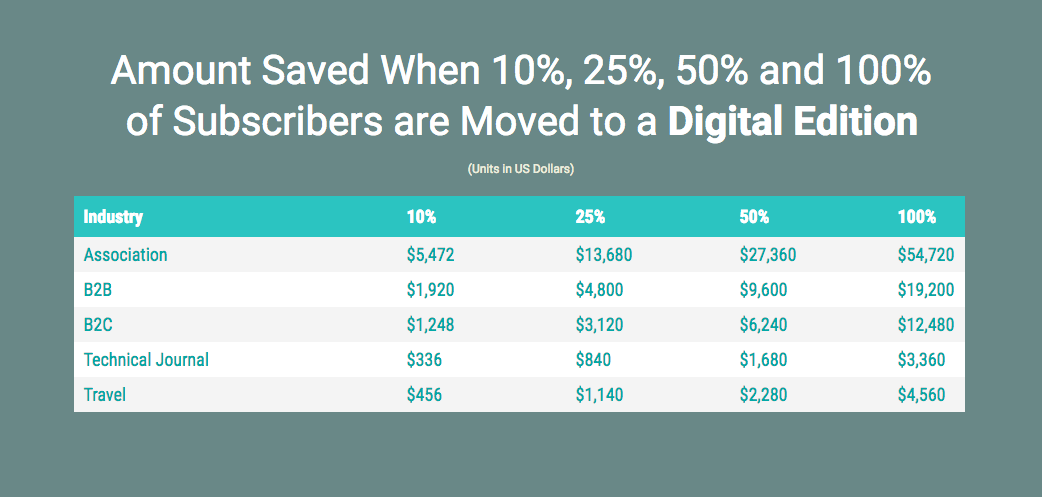Analyzing The Merits of Turning Print into Digital Edition Subscribers

Written by Matt Clement
July 30, 2018
As a quick note to start, let us say that we are not cutting down print in this article. Understanding trends in the publishing industry, we know that this medium continues to be a viable channel for sharing content with many audiences and a profitable venture for many publishers. Our managing partners actually started businesses in the printing world and hence fully understand that the medium has clear merits.
At the same time, we keep a keen eye on global trends and see that readers around the world are moving to digital content experiences when they are available. Noticing these trends as well, large publishers are making moves towards print reductions and the usage of digital platforms. A recent PwC report, Transitioning from A Print Past to A Digital Future, had this to say “strategic cost reduction will remain a focus (for the publishing industry) – witness the moves by The Wall Street Journal to collapse sections of its newspaper, and by Condé Nast to move Self to an all-digital publication.”
The adoption of digital editions specifically is backed through market research by organizations such as Gfk. In a recent article, the German thinktank indicated a year over year 27% increase in digital edition magazine readership worldwide. One of the great drivers of digital edition adoption and a differentiator of the medium is that it provides a comfortable bridge between print and a website. Digital editions allow a reader to get the rich feel of a curated experience but with the convenience of digital. A website, on the other hand, leaves a level of uncertainty, as the picking and choosing of information by the reader can often lead them to feel like they missed part of the content experience that is captured so well in a curated content platform such as a print or digital edition.
Taking all this into summation:
- The world is moving in a digital content consumption direction
- Publishers understand this and are making moves towards cutting print and enhancing digital
- Digital edition reader growth year over year continues to be robust
- Digital editions provide a solid bridge between the print and the digital world
At the bottom of it all though, costs many times drive change. That said, we took the time to analyze the cost savings that come with a switch. In order to understand this, we used the information given to us by a standard US-based large-scale publisher to determine the cost of producing and mailing a 64-page print magazine. They were as follows:
- North American: $0.48 per copy
- International: $1.32 per copy
We then took this data and extrapolated it out to the five selected publications we examined in our last post. In turn, we were able to calculate the savings each of these magazines gain through distributing digital editions instead of print editions. For analysis sake, we also broke down their savings if they hypothetically had moved only 10%, 25%, and 50% of this audience. It’s important to note that the selected technical journal and travel publication currently have small digital edition circulations of 7000 and 9500 respectively. The cost savings are highlighted in the chart below:

The cost savings indicated here do not take into account savings in regards to international distribution of print, which almost triples costs. In essence, we are assuming all these digital edition subscribers would have received the North American edition. In almost all cases, the savings of moving a small portion of an audience over to digital more than pay for the production of a digital edition.
When thinking about the switch to digital, it is completely normal for the transition to seem a bit daunting. Regardless of feelings or considerations, there are a few important things to know before jumping over to digital editions.
- It doesn’t need to happen overnight. Many companies ease into digitizing their magazines, offering trials to a subset of subscribers that span their audience personas. This allows time to gauge how readers are responding in each audience and how likely they are to be satisfied with the change.
- Think about leveraging digital only advertisements through a digital edition. Ads in this medium provide new ways of advertising and oftentimes attract a new type of sponsor, hence allowing for the building up of a new revenue stream. This helps to cover the cost of producing a digital edition and allowing all the savings from the switch to be reinvested in other manners.
- Invest in a top-notch digital edition format. In asking readers to make a change, which they may be averse to, they need to be switching to a quality experience. We may be a little biased, but we would suggest our PageRaft platform for how well it works on every device and its intuitive interface.
If you happen to have any questions about the transition or your content strategy, don’t hesitate to reach out to us. We would be glad to discuss and help you uncover if the move to digital is a solid one for your audiences and your content. We are here to help.